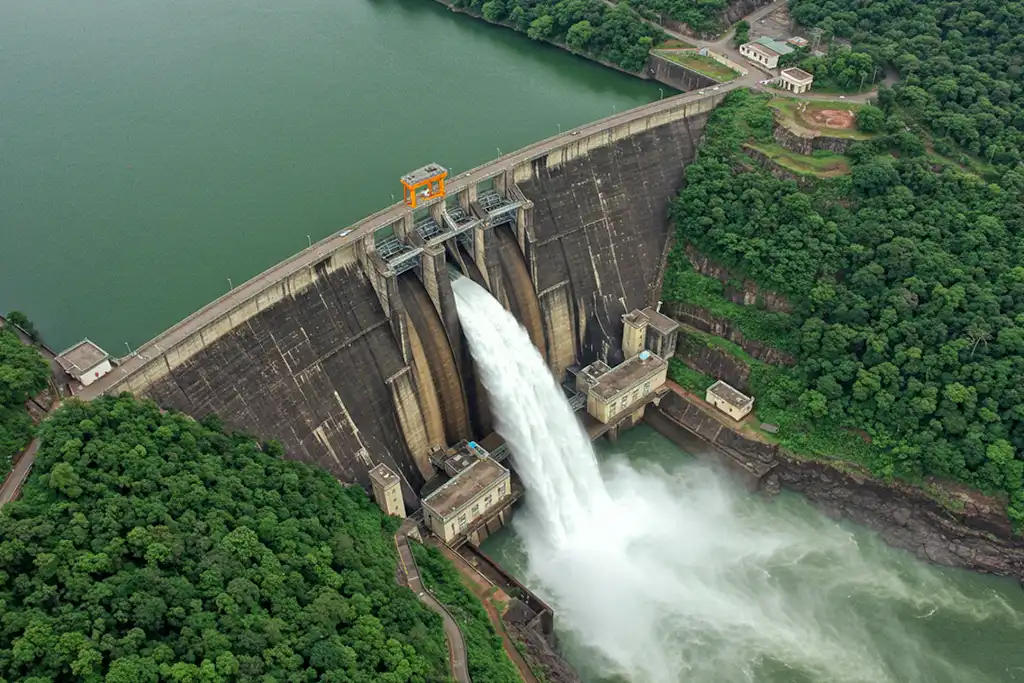
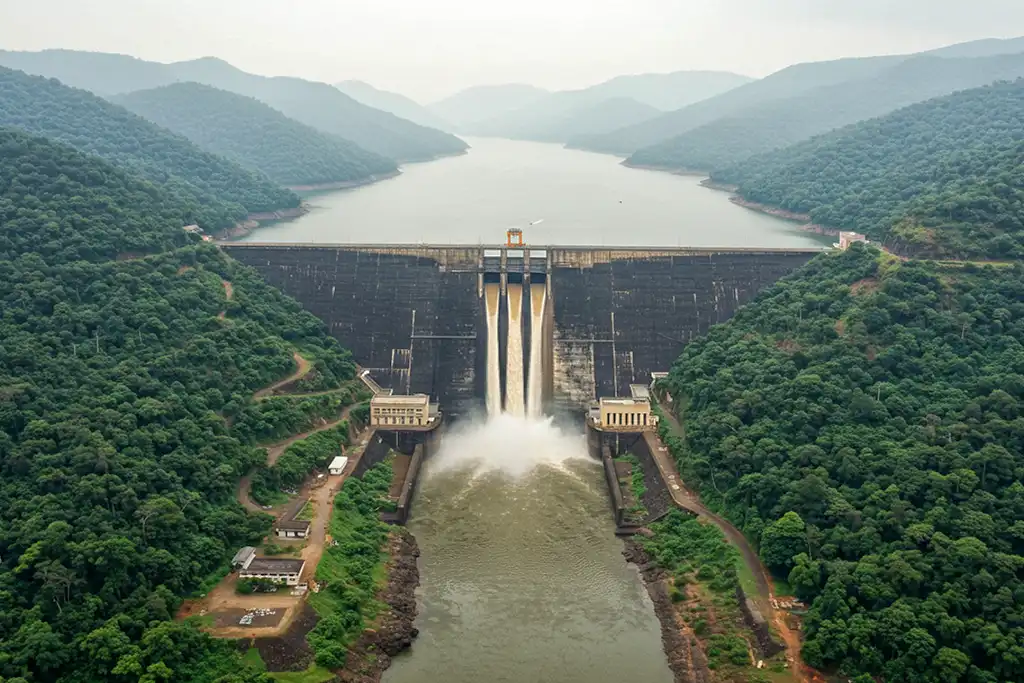
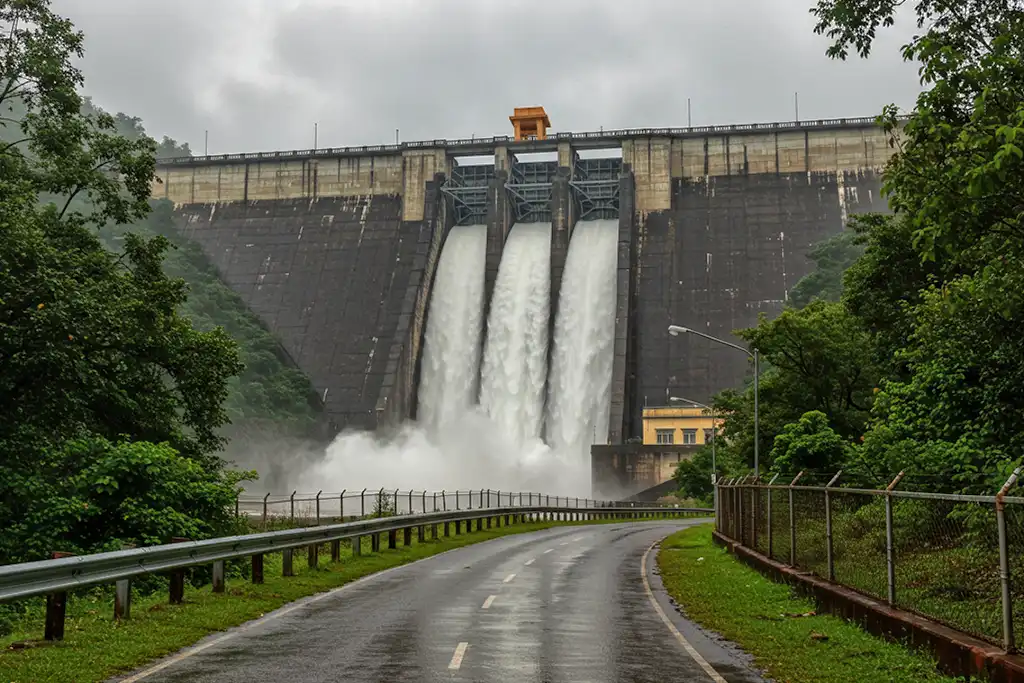
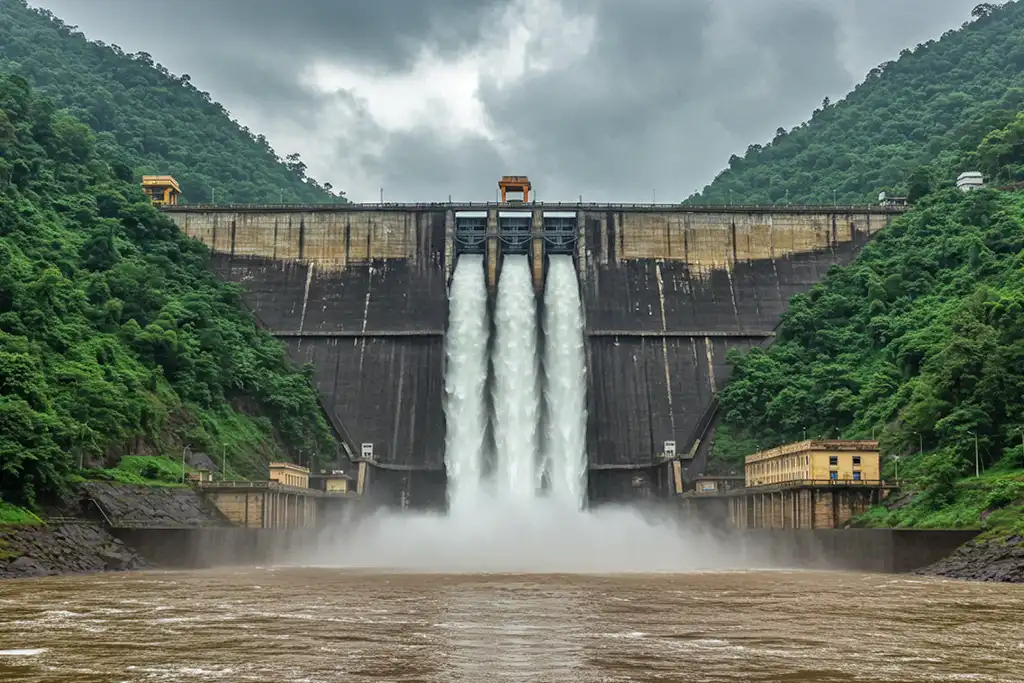
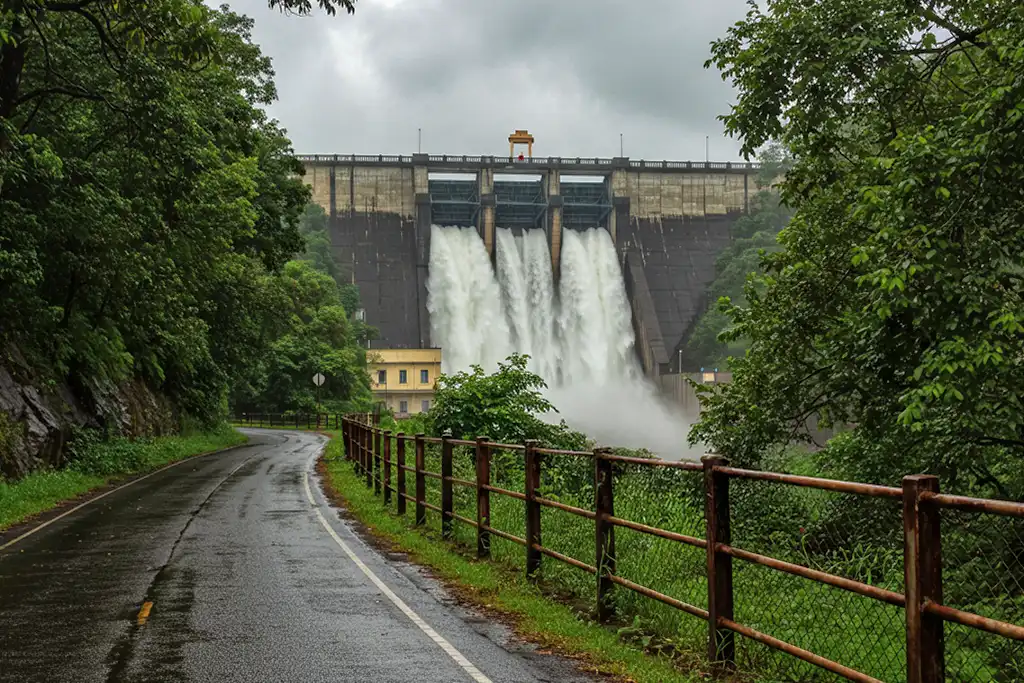
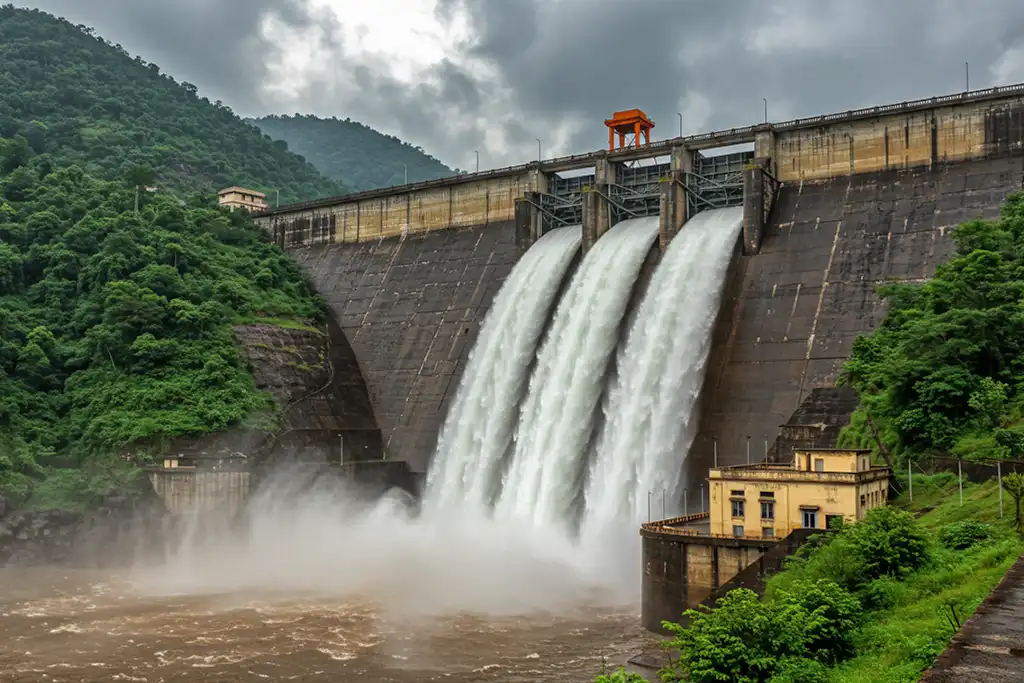
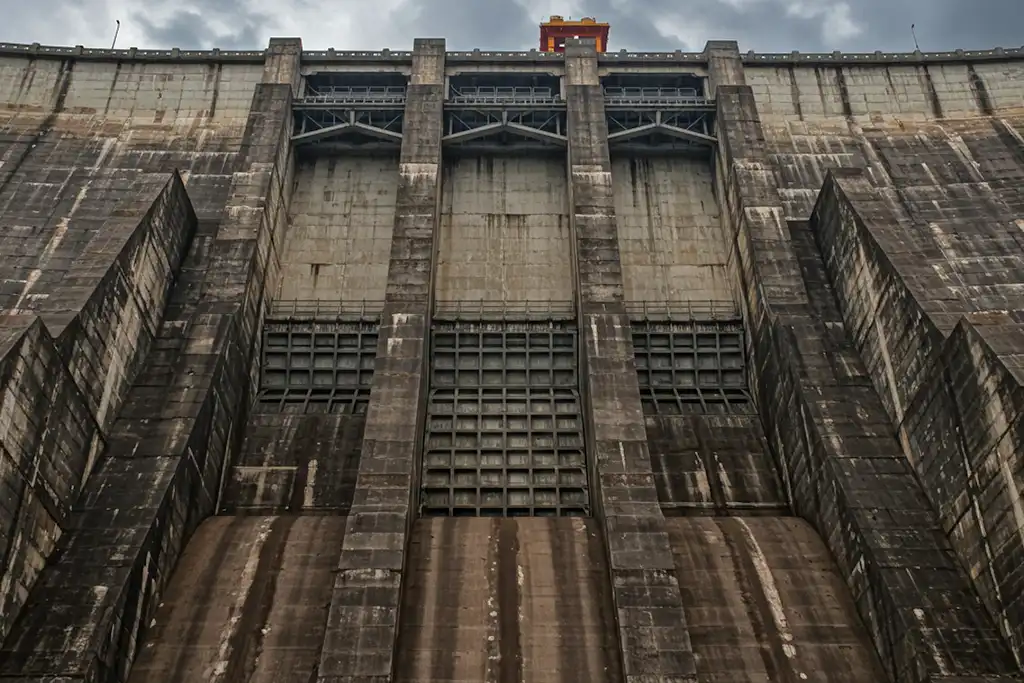
Supa Dam
Karnataka’s Hidden Powerhouse in the Wild Western Ghats
Where Exactly Is Supa Dam?
- Location: Joida Taluk, Uttara Kannada District, Karnataka.
- Nearest Towns: Dandeli (approx. 22 km), Karwar (87 km), Hubballi (128 km).
- Getting There:
- By Road: Well-connected via NH-52 from Hubballi and NH-66 from Karwar.
- By Rail: Closest station is Alnavar Junction (about 57 km away).
- By Air: Hubballi Airport is the nearest (128 km).
Why Was Supa Dam Built?
- Primary Purpose: Hydroelectric power generation for northern Karnataka.
- Secondary Use: Water regulation and possible support for irrigation.
- Significance: Powers industries, supports local agriculture, and sustains ecological flows.
Supa Dam’s History
The idea of harnessing the untamed flow of the Kali River began taking shape in the 1960s. The region needed a robust infrastructure project to meet the growing electricity demand in Karnataka.
Construction Timeline
- Project Initiation: Late 1960s
- Completion: 1987
- Type: Concrete gravity dam — solid, stable, and built to last
Structural Highlights
- Height: 101 meters
- Length: 332 meters
- Width at Base: Approx. 50 meters
Supa Reservoir
- Known As: Supa Backwaters
- Storage Capacity: 4,178 million cubic meters
- Area Covered: 145 sq. km approx.
- Submerged Villages: Several small settlements were displaced, though detailed public records are limited
Powering Karnataka: Technical Insights
Supa Dam is the beating heart of the Kali Hydroelectric Project, managed by Karnataka Power Corporation Limited (KPCL). Its massive structure isn’t just for show — it’s a lifeline of renewable energy for northern Karnataka.
Power Generation Setup
- Powerhouse Location: Near Ambikanagar, downstream from the dam
- Turbines: 2 Francis-type turbines
- Installed Capacity: 100 MW (2 x 50 MW units)
- Annual Generation: Approx. 400–500 GWh depending on rainfall
Water Management
- River: Built on the Kali River, one of Karnataka’s major west-flowing rivers
- Flow Regulation: Plays a key role in managing downstream flow and preventing seasonal floods
Can’t decide where to stay or what to do in Dandeli?
We simplify everything — from stay to activities. Quick advice from locals, no pressure, just clarity.
Supa Dam for Travelers
Though Supa Dam itself isn’t a full-fledged tourist hub, the area around it offers serene views, fresh air, and untouched natural beauty — making it a must-stop for those visiting Dandeli or exploring the Western Ghats.
Best Time to Visit
- Monsoon (June–September): Lush greenery and overflowing backwaters make it breathtaking.
- Winter (November–February): Clear skies and cool weather create perfect sightseeing conditions.
Things to Do
- Viewpoints: Get panoramic dam views from roadside turns and forest openings.
- Photography: Most public spots allow photography. Drone usage may need prior permission.
Nearby Places Worth Visiting
- Dandeli: Famous for white-water rafting, eco-camps, and jungle adventures.
- Syntheri Rocks: Giant limestone formations nestled deep in the forest.
- Shiroli Peak: Known for sunset views and hilltop breezes.
- Kavala Caves: Underground caves with ancient stalagmite formations.
- Ulavi Temple: A forest pilgrimage spot with light trekking trails.
Activities Around the Dam
- Boating: Offered in parts of Supa backwaters closer to Dandeli.
- Trekking & Birdwatching: Forest trails nearby are home to hornbills, woodpeckers, and butterflies.
Where to Stay
- Homestays & Resorts: Dandeli offers plenty of jungle lodges, riverside tents, and eco-resorts to suit all budgets.
Local Food
- Must-Try: Jolad rotti meals with palya, chutneys, and traditional North Karnataka fare. Local eateries near Dandeli serve authentic dishes.
Timings & Entry
- Access: Public access to dam surroundings is allowed, but entry inside powerhouse is restricted.
- Entry Fee: None for general viewing zones.
Visitor Tips
- Carry your waste back — avoid plastic in forest zones.
- Respect signs and security instructions near the dam.
Nature and the Dam: A Delicate Balance
Supa Dam rests at the gateway of one of India’s most biodiverse zones — the Western Ghats. While it powers homes and industries, it also intersects with a vibrant ecosystem full of rare flora and fauna.
Wildlife & Greenery
- Species Seen: Malabar giant squirrels, elephants, leopards, kingfishers, and hornbills are commonly spotted in nearby forests.
- Flora: Teak, bamboo, and a wide range of medicinal herbs thrive here due to the rich, moist soil and dense canopy.
Environmental Impact
- Positive Aspects:
- Creation of aquatic ecosystems in the backwaters
- Support for renewable hydroelectric power
- Challenges:
- Altered flow patterns affecting aquatic species downstream
- Displacement of some local communities and forest habitats
Conservation Efforts
- Forest Department teams and local NGOs regularly monitor wildlife activity and run awareness programs in Dandeli and surrounding regions.
- Eco-tourism initiatives are being developed to balance nature conservation with travel interest.
Did You Know? Supa Dam Trivia
Supa Dam isn’t just an engineering project—it’s surrounded by stories, superlatives, and surprising details that many visitors and even locals don’t always know.
Trivia & Lesser-Known Facts
- Name Origin: The name “Supa” comes from a now-submerged village called Supa that existed before the dam’s construction.
- Engineering Marvel: Supa Dam is one of Karnataka’s tallest and largest-volume gravity dams.
- Monsoon Spectacle: During heavy rains, the dramatic water release from the spillway turns into a thunderous, roaring cascade—truly a hidden natural spectacle.
- Local Lore: Some locals believe that a submerged temple from the old Supa village occasionally becomes visible when water levels drop significantly.
- Backwater Biodiversity: Supa Reservoir, also known as Supa Backwaters, has turned into a quiet haven for migratory birds and aquatic life, attracting nature watchers and photographers alike.
These fascinating details make Supa Dam more than just a functional structure—it’s a place with history, mystery, and natural beauty all rolled into one.
Must Visit Places in Dandeli

Wildlife Sanctuary

Kavala Caves

Supa Dam

Moulangi Eco Park

Shiroli Peak

Disney Park

Sykes Point

Back Water

Anshi National Park
FAQs About Supa Dam
Where is Supa Dam located
Which river is Supa Dam built across
What is the main purpose of Supa Dam
What is the height of Supa Dam
When was Supa Dam built/commissioned
Can we visit Supa Dam? What are the visiting hours







Supa Dam: Karnataka's Hidden Powerhouse in the Wild Western Ghats
Supa Dam at a Glance
Tucked deep within the lush forests of the Western Ghats, Supa Dam is not just an engineering marvel — it’s a vital artery for Karnataka’s energy needs and a serene escape for nature lovers. Built across the mighty Kali River, this concrete gravity dam is the centerpiece of the Kali Hydroelectric Project and a hidden gem just a short drive from Dandeli.
Where Exactly Is Supa Dam?
Location: Joida Taluk, Uttara Kannada District, Karnataka.
Nearest Towns: Dandeli (approx. 22 km), Karwar (87 km), Hubballi (128 km).
Getting There:
By Road: Well-connected via NH-52 from Hubballi and NH-66 from Karwar.
By Rail: Closest station is Alnavar Junction (about 57 km away).
By Air: Hubballi Airport is the nearest (128 km).
Why Was Supa Dam Built?
Primary Purpose: Hydroelectric power generation for northern Karnataka.
Secondary Use: Water regulation and possible support for irrigation.
Significance: Powers industries, supports local agriculture, and sustains ecological flows.
A Journey Through Time: Supa Dam’s History
The idea of harnessing the untamed flow of the Kali River began taking shape in the 1960s. The region needed a robust infrastructure project to meet the growing electricity demand in Karnataka.
Construction Timeline
Project Initiation: Late 1960s.
Completion: 1987.
Type: Concrete gravity dam — solid, stable, and built to last.
Structural Highlights
Height: 101 meters
Length: 332 meters
Width at Base: Approx. 50 meters
Supa Reservoir
Known As: Supa Backwaters
Storage Capacity: 4,178 million cubic meters
Area Covered: 145 sq. km approx.
Submerged Villages: Several small settlements were displaced, though detailed public records are limited.
Powering Karnataka: Technical Insights
Supa Dam is the beating heart of the Kali Hydroelectric Project, managed by Karnataka Power Corporation Limited (KPCL).
Power Generation Setup
Powerhouse Location: Near Ambikanagar, downstream from the dam.
Turbines: 2 Francis-type turbines
Installed Capacity: 100 MW (2 x 50 MW units)
Annual Generation: Approx. 400–500 GWh depending on rainfall
River & Water Management
River: Built on the Kali River, one of Karnataka’s major west-flowing rivers.
Flow Regulation: Plays a key role in managing downstream flow and preventing seasonal floods.
Need help planning your Dandeli trip?
We’ll Guide you — Stay, Activities, Everything Made Simple.
Supa Dam for Travelers: Calm, Scenic & Worth a Visit
Though Supa Dam itself isn’t a typical tourist spot with large infrastructure for visitors, its surroundings are calm, clean, and wildly beautiful.
Best Time to Visit
Monsoon (June–September): Lush greenery and overflowing backwaters.
Winter (November–February): Clear skies, pleasant breeze, great for photos.
Things to Do
Viewpoints: Scenic dam view from nearby roads and forest clearings.
Photography: Allowed in most public areas, but drones may require permission.
Nearby Places:
Dandeli: River rafting, wildlife sanctuary, eco camps.
Syntheri Rocks: Massive monolithic limestone formation.
Shiroli Peak: Stunning sunset point within Dandeli Wildlife Sanctuary.
Kavala Caves: Ancient caves with stalagmite formations.
Ulavi Temple: Sacred site with forest trek.
Activities Nearby
Boating: Available in some backwater regions closer to Dandeli.
Trekking & Birdwatching: The Western Ghats are full of vibrant species.
Where to Stay
Homestays & Resorts: Dandeli offers dozens of options — from riverside tents to luxurious eco resorts.
Local Food
Traditional North Karnataka meals (jolad rotti, palya, sambar) are a must-try. Small eateries near Dandeli cater to visitors.
Timings & Entry Fees
Public Access: Viewpoints and dam vicinity are accessible; entry into the powerhouse area is restricted.
Entry Fee: None for general viewing areas.
Visitor Tips
Avoid plastic, respect local wildlife.
Follow local signs and security guidelines around the dam area.
Nature and the Dam: A Delicate Balance
Supa Dam lies at the edge of one of the most biodiverse regions in the world — the Western Ghats.
Wildlife & Greenery
Home to species like Malabar giant squirrels, hornbills, kingfishers, leopards, and elephants.
Dense forests with teak, bamboo, and medicinal herbs.
Environmental Impact
Positive:
Created new aquatic habitats.
Supported renewable energy initiatives.
Challenges:
Altered river flow affecting downstream aquatic life.
Submerged habitats and displacement.
Conservation
Forest Department and NGOs are active in Dandeli for wildlife protection and sustainable tourism.
Did You Know? Supa Dam Trivia
Name Origin: “Supa” comes from the submerged village Supa.
Engineering Feat: Among Karnataka’s largest dams by volume and height.
Hidden Fact: During monsoon overflow, the roaring outflow creates a natural spectacle few get to witness.
Local Story: Some locals believe the submerged temple of Supa village occasionally emerges when the water level drops drastically.
FAQs About Supa Dam
Supa Dam is located in Ganeshgudi, Joida Taluk, Uttara Kannada district, Karnataka, India. It’s situated near the popular tourist destination of Dandeli.
Supa Dam is built across the Kali River (also known as Kalinadi) in Karnataka.
The primary purpose of Supa Dam is hydroelectric power generation. It is a crucial part of the Kali River Hydroelectric Project, contributing significantly to Karnataka’s electricity supply.
Supa Dam has a height of 101 meters (331 feet), making it the tallest dam in Karnataka.
The construction of Supa Dam began in 1974 and was completed in 1987. Its power house was commissioned in 1985.
Yes, Supa Dam is a popular tourist attraction. While access to the immediate dam structure might be restricted, the viewing points and surrounding areas are generally accessible. Typical visiting hours for tourist views are from 9:00 AM to 5:00 PM, but it’s always advisable to check locally for any changes or specific area restrictions.
